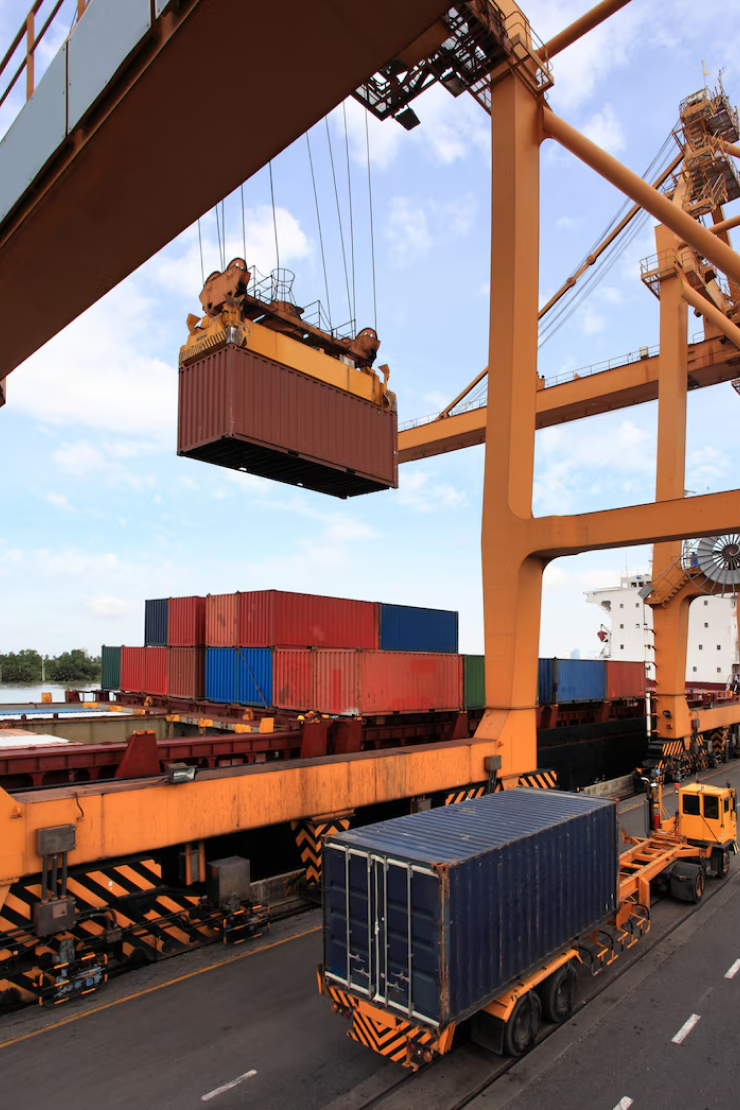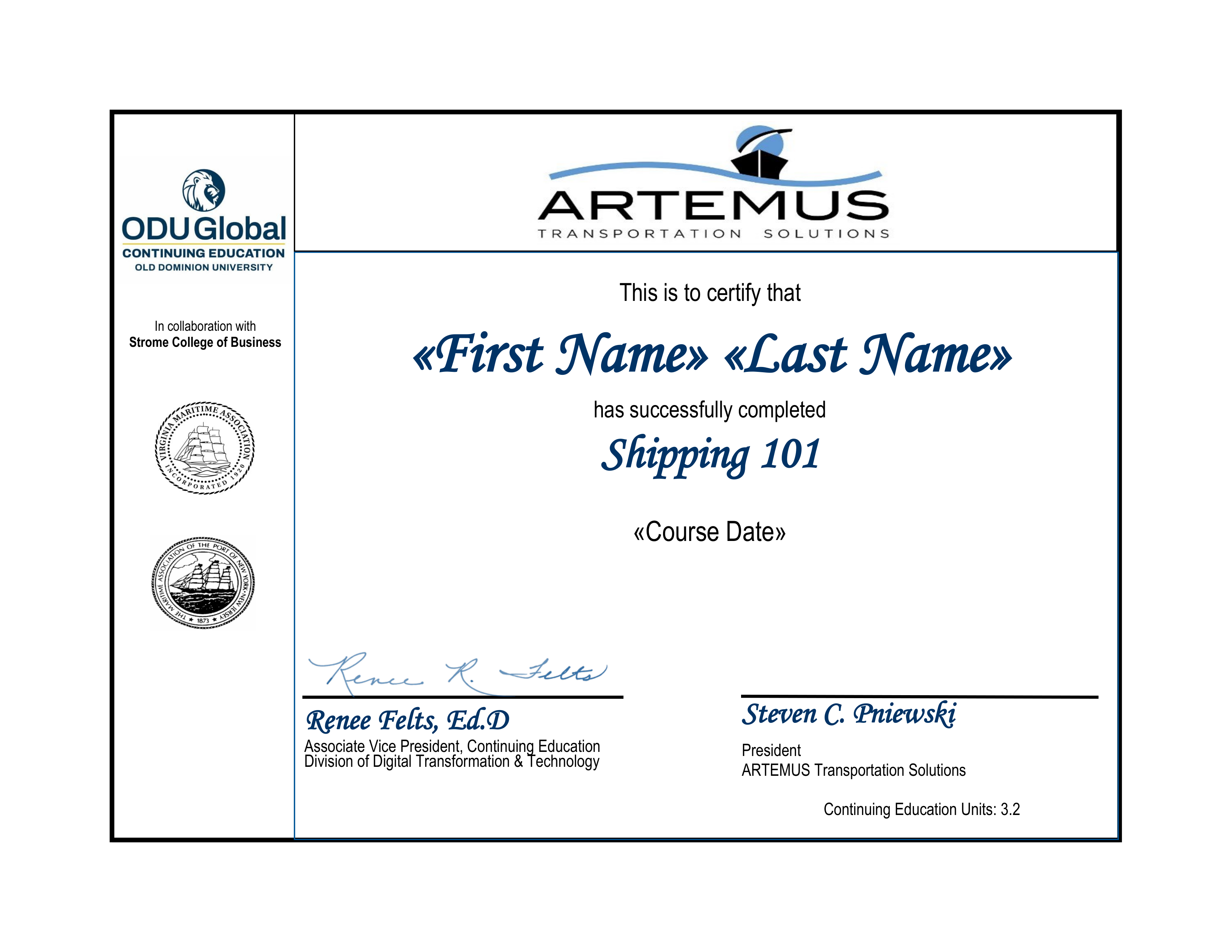Course Overview
Develop a thorough understanding of equipment management within the shipping industry. Learn about container types and their uses to the intricacies of maintaining & controlling equipment flow.
- Introduction To Ocean Containers
- The Container Cycle
- The Goal Of Equipment Control
- Maintenance & Repair
- Owning VS Leasing Equipment
- Efficient Equipment Management Practices
What You Will Learn?
This course provides a thorough understanding of equipment management in shipping, equipping you with the right skills. You’ll learn to balance ownership and leasing decisions while implementing efficient management practices to enhance overall operational performance.
Introduction To Ocean Containers
Explore the various types of ocean containers, their specific functions, and how they are designed to accommodate different types of cargo, ensuring safe and efficient transport.
The Container Cycle
Understand the complete container cycle, from loading to unloading, and learn the processes required to maintain a smooth flow of containers throughout the supply chain.
The Goal Of Equipment Control
Discover effective strategies for managing equipment control, focusing on maintaining equipment pools and ensuring optimal usage for seamless operations.
Maintenance & Repair
Learn how to identify equipment damage, assess repair needs, and determine responsibility for repairs to minimize downtime and maintain efficiency.
Owning VS Leasing Equipment
Analyze the pros and cons of owning versus leasing equipment, focusing on financial, operational, and flexibility aspects to make informed decisions.
Efficient Equipment Management Practices
Master the best practices for managing equipment in a cost-effective, reliable manner, enhancing operational performance and reducing inefficiencies.
By Artemus Transportation Solutions
With a dedicated legacy since 2004, Artemus Transportation Solutions has become a trusted leader in transportation compliance solutions, offering cutting-edge ISF, AMS, Customs Broker, & eManifest Canada & Japan AFR software. Our years of hands-on industry experience allow us to deliver impactful training courses that go beyond theory, empowering professionals with real-world knowledge.
- 19+ Years of Expertise in Global Transportation Compliance Solutions.
- Practical, real-world insights into Customs, Import, and Export processes.
- Hands-on training in managing complex transportation equipment logistics.
- Efficient solutions for navigating International Shipping and related challenges.

Recognized Certification From Artemus Transportation Solutions
Upon completing the International Shipping course, you'll receive a Certificate of Completion from Artemus Transportation Solutions. This certification highlights your expertise in global shipping processes & compliance, making it a valuable addition to your skills.

Our Reviews
Frequently Asked Questions
Who Is The Course Designed For?
This course is tailored for professionals at all levels, from beginner to intermediate learners, who are looking to enhance their knowledge of global shipping, logistics, & compliance.
What Topics Are Covered In The Equipment Management Course?
The course covers key aspects of equipment management in the shipping industry, including ocean containers, the container cycle, equipment control goals, maintenance and repair practices, equipment ownership vs leasing, and efficient management strategies.
What Is The Goal Of Equipment Control In Shipping?
The goal of equipment control is to optimize the availability and flow of shipping containers and other equipment, ensuring that they are properly maintained, utilized, and accounted for throughout their lifecycle. This helps reduce costs and prevent operational disruptions.
Will I Receive A Certification Upon Course Completion?
Yes, you’ll receive a Certificate of Completion from Artemus Transportation Solutions, which can be showcased on your professional profiles.
Are The Courses Self-Paced Or Instructor-Led?
This course offers a flexible, self-paced learning format with video pre-recorded lessons, allowing you to complete them at your convenience. This approach enables you to learn at your own pace & revisit material as needed.
Do I Need Prior Experience In Shipping Or Logistics To Take This Course?
While prior experience is helpful, our beginner & intermediate-level courses provide foundational knowledge, making them accessible even for those new to the industry.
How Can This Course Benefit My Career?
By completing this course, you’ll gain practical, real-world insights that can boost your skills, enhance your compliance knowledge, & advance your career in the shipping & logistics industry.
What Makes Artemus’s Equipment Management Course Different From Others?
Artemus’s Equipment Management course is unique due to its detailed, hands-on approach to managing shipping equipment. It covers critical topics like container types, lifecycle management, and maintenance strategies, giving learners the practical tools needed to efficiently manage equipment and improve operational performance in the shipping industry.
Equipment Management Course: Get familiar with equipment handling topics and terms
Ocean container tracking: how to monitor shipments efficiently
Ocean container tracking is essential for ensuring real-time visibility of cargo movement. Advanced GPS technology, RFID tags, and online tracking platforms enable shippers to monitor container locations accurately. Tracking systems provide crucial updates on estimated arrival times, potential delays, and customs clearance statuses. Many global shipping companies offer integrated tracking solutions that enhance supply chain efficiency. Understanding how to interpret tracking data can help businesses mitigate risks and improve delivery timelines. Investing in reliable tracking solutions ensures smoother international shipping operations.
Ocean container: understanding its role in global trade
An ocean container is a standardized metal box used to transport goods across seas and oceans. These containers come in various sizes and are designed to facilitate secure and efficient global trade. They protect cargo from harsh environmental conditions and minimize handling time at ports. Ocean containers are a key component of intermodal transport, seamlessly shifting between ships, trucks, and trains. With the rise of e-commerce and global supply chains, their demand continues to grow. Their role in reducing shipping costs and enhancing logistics efficiency makes them indispensable in global trade.
Ocean container dimensions: key measurements you need to know
Understanding ocean container dimensions is crucial for selecting the right container for your cargo. Standard containers typically come in 20-foot and 40-foot sizes, with variations like high cubes offering extra vertical space. The internal and external dimensions, as well as door openings, impact cargo loading and storage capacity. Knowing the exact measurements helps prevent cargo damage and ensures compliance with shipping regulations. Weight limitations also play a role in determining the suitable container for heavy or oversized shipments. Proper planning based on container dimensions can optimize logistics and cost efficiency.
Ocean container sizes and their applications in shipping
Ocean containers come in different sizes to accommodate a variety of cargo types. The most common sizes are 20-foot and 40-foot containers, used for general cargo transportation. High-cube containers provide additional height for oversized shipments, while refrigerated (reefer) containers maintain temperature-sensitive goods. Open-top and flat-rack containers are ideal for heavy machinery and bulky items. Choosing the right size ensures optimal space utilization and cost efficiency. Understanding container size applications helps businesses streamline their shipping operations.
Ocean container measurements: standard and specialized options
Standard ocean container measurements include 20-foot and 40-foot lengths, with 8-foot width and 8.5-foot height. High-cube containers extend to 9.5 feet in height for added storage. Specialized containers like reefers, open-top, and tank containers have customized dimensions to suit specific cargo needs. Internal dimensions differ from external ones due to container walls and flooring. Cargo weight distribution plays a crucial role in maintaining stability and compliance with regulations. Selecting the correct container measurements ensures safe and efficient transportation.
Ocean container specifications fofr international freight
Ocean container specifications determine the suitability of a container for international shipping. These specifications include dimensions, weight capacity, and structural integrity. Containers must comply with ISO standards for intermodal transport compatibility. Features like ventilation, insulation, and locking mechanisms enhance cargo security. Understanding these specifications helps businesses choose containers that align with freight requirements. Properly specified containers ensure regulatory compliance and safe delivery of goods across borders.
Ocean containers: types, uses, and shipping considerations
Ocean containers come in multiple types, including dry containers, refrigerated containers, open-top, and flat-rack containers. Dry containers are widely used for general cargo, while reefers are essential for perishable goods. Open-top containers accommodate oversized cargo, and flat-racks transport heavy machinery. Factors like cargo type, weight, and destination influence container selection. Proper understanding of container types ensures efficient shipping logistics and cost-effective transportation.
Ocean container shipping: how it works and best practices
Ocean container shipping involves multiple steps, from booking and loading to customs clearance and delivery. Containers are transported via large cargo ships along major shipping routes. Best practices include proper cargo securing, accurate documentation, and choosing reliable shipping partners. Efficient route planning minimizes transit times and reduces costs. Tracking systems enhance visibility and prevent delays. Following best practices ensures smooth and timely global shipping operations.
Shipping containers floating in ocean: causes and prevention
Shipping containers can float in the ocean due to extreme weather, rough seas, or improper loading. Improperly secured containers may fall off vessels during storms or heavy waves. Prevention measures include proper weight distribution, secure lashing techniques, and strict adherence to international shipping regulations. Innovations like improved locking systems and onboard tracking help reduce container losses. Floating containers pose risks to marine traffic and the environment. Ensuring proper container security can minimize these risks and prevent shipping losses.
Ocean freight rates 20' container: cost and pricing factors
The cost of shipping a 20-foot container depends on various factors, including distance, fuel prices, demand, and port charges. Rates fluctuate based on market conditions, seasonal demand, and geopolitical factors. Additional costs like customs duties, insurance, and inland transportation can impact the final price. Shippers should compare freight rates from different carriers to get the best deal. Negotiating long-term contracts or using freight forwarders can help secure competitive pricing. Understanding these factors ensures cost-effective shipping decisions.
Ocean freight rates 40' container: key influences on pricing
Freight rates for a 40-foot container vary based on cargo type, route, and shipping line policies. The larger capacity makes it cost-effective for bulk shipments, but prices depend on supply chain disruptions, fuel surcharges, and port congestion. Container availability and peak seasons also affect pricing. Businesses should monitor global freight trends and book shipments in advance to secure lower rates. Utilizing freight rate calculators and working with experienced logistics providers can optimize shipping costs.
Do shipping containers float in the ocean? Myths and facts
A common misconception is that all shipping containers float indefinitely. In reality, standard containers may stay afloat temporarily due to trapped air but will eventually sink as they take on water. Weather conditions and cargo weight impact their buoyancy. Some containers with sealed air-tight cargo may float longer. Incidents of floating containers pose risks to marine navigation and ecosystems. Understanding these risks helps shippers adopt better container securing methods to prevent losses at sea.
Sea container: what it is and how it's used in trade
A sea container is a durable, standardized shipping box used for transporting goods across international waters. It ensures secure and efficient movement of cargo through ports, ships, and intermodal transport systems. Common types include dry containers, reefers, and open-top containers. These containers facilitate global trade by reducing handling time and ensuring cargo safety. Many industries rely on sea containers to streamline supply chains and reduce logistics costs. Their standardized structure allows for easy stacking and transport across multiple modes.
Sea containers: importance in global logistics
Sea containers revolutionized international trade by enabling large-scale, secure, and cost-effective transportation. They support economies by facilitating exports and imports across continents. Standardization ensures seamless movement across ships, trucks, and trains. Modern innovations include smart containers with GPS tracking and temperature control for sensitive cargo. Containerization has significantly improved port efficiency and global supply chain operations. Investing in proper container selection and handling enhances shipping reliability.
20 foot sea container: dimensions and common uses
A 20-foot sea container is a widely used shipping unit with standard dimensions of 20’L x 8’W x 8.5’H. It has a storage capacity of approximately 33 cubic meters, making it ideal for small to medium shipments. These containers are commonly used for retail goods, furniture, and machinery. They offer flexibility for domestic and international shipping while being easier to transport than larger containers. Many businesses prefer 20-foot containers for cost-effective shipping solutions. Understanding their specifications ensures efficient cargo planning.
Sea container tracking: how to keep tabs on your cargo
Tracking sea containers is crucial for supply chain visibility and cargo security. GPS-based tracking systems, RFID technology, and online tracking portals help monitor container locations in real time. Shipping lines provide tracking numbers that allow shippers to check container movement. Delays, transshipment details, and estimated arrival times can be accessed through tracking systems. Effective tracking reduces risks of lost shipments and enhances delivery planning. Investing in reliable tracking tools improves shipping efficiency and customer satisfaction.
Sea container specifications: understanding industry standards
Sea containers follow ISO specifications to ensure compatibility in global shipping. Standard sizes include 20-foot, 40-foot, and high-cube variations. Key specifications cover weight limits, structural integrity, and ventilation. Different container types, such as reefers or flat-rack containers, have additional features based on cargo needs. Compliance with international regulations ensures safe transport and smooth customs clearance. Understanding these specifications helps businesses choose the right container for their cargo.
Sea container specs: what shippers need to know
Shippers must understand the technical specifications of sea containers to ensure efficient cargo handling. Specs include internal and external dimensions, door width and height, payload capacity, and weight restrictions. Containers must meet structural integrity standards to withstand ocean conditions. Ventilation, insulation, and temperature control are crucial for perishable goods. Choosing the right specs enhances cargo safety and reduces logistical challenges. Shippers should consult carriers to select containers best suited to their shipment needs.
Container cycle: the journey of a shipping container
A shipping container goes through multiple stages in its life cycle, starting from manufacturing and first use in transportation. It then moves between different trade routes, ports, and warehouses before returning empty or being repurposed. Containers may undergo maintenance, leasing, or resale based on their condition. Tracking the container cycle helps optimize asset utilization and reduce costs. Efficient container management ensures availability for future shipments.
Container life cycle management: maximizing efficiency
Managing a container’s life cycle involves proper handling, maintenance, and strategic deployment. Containers transition between active shipping, storage, and repair phases. Companies use tracking systems to monitor container usage and location. Proper management minimizes losses due to damage, theft, or inefficiencies. Recycling or repurposing old containers contributes to sustainability. Implementing a structured life cycle strategy enhances cost savings and logistics efficiency.
Container shipping cycle: key stages in global trade
The container shipping cycle includes booking, loading, transportation, unloading, and return. Containers move between ports, warehouses, and inland distribution points. Logistics planning ensures smooth coordination between carriers and customs authorities. Optimizing the shipping cycle reduces delays and operational costs. Understanding the full cycle helps businesses improve supply chain management. Digital tracking tools and automation streamline each stage for maximum efficiency.
Shipping container maintenance: tips for longevity
Regular maintenance extends the lifespan of shipping containers and ensures cargo safety. Key maintenance tasks include checking for rust, repairing dents, and inspecting door seals. Waterproof coatings help prevent corrosion from ocean exposure. Proper ventilation and pest control measures protect stored goods. Scheduled inspections prevent structural failures and costly repairs. Investing in maintenance enhances the durability and reliability of containers.
Shipping container maintenance and repair: best practices
Effective maintenance and repair strategies keep containers in optimal condition for shipping. Inspections should cover flooring integrity, locking mechanisms, and weatherproofing. Dented or corroded sections should be repaired promptly to prevent leaks. Routine cleaning prevents contamination for food-grade and medical shipments. Partnering with certified container repair services ensures compliance with industry standards. Proactive maintenance reduces long-term costs and enhances container performance.
Lease to own shipping containers: pros and cons
Leasing to own shipping containers offers flexibility for businesses needing long-term container solutions. It allows companies to spread payments over time instead of purchasing outright. Pros include lower upfront costs, tax benefits, and access to quality containers. However, leasing contracts may come with interest rates and restrictions. Businesses must evaluate whether buying outright or leasing is more cost-effective. Understanding contract terms ensures informed financial decisions.
Shipping container leasing: a guide for businesses
Leasing shipping containers is a popular option for companies needing temporary or scalable storage and transport solutions. Leasing provides access to high-quality containers without significant capital investment. Short-term and long-term leasing options cater to different business needs. Considerations include lease duration, maintenance responsibilities, and return policies. Leasing agreements should be reviewed carefully to ensure cost-effectiveness. Choosing a reputable leasing provider ensures smooth logistics operations.
FAQs
-
What is equipment management in shipping?
Equipment management in shipping refers to the process of overseeing, tracking, and maintaining shipping containers, chassis, and other transport equipment. It ensures that containers are available, in good condition, and efficiently utilized to minimize costs and delays.
-
Why is equipment management important for logistics?
Effective equipment management helps optimize fleet utilization, reduce operational costs, and prevent delays in cargo movement. It also ensures compliance with international shipping regulations and minimizes container shortages or excess inventory.
-
What types of shipping equipment are managed?
Common types of shipping equipment include dry containers, refrigerated (reefer) containers, open-top containers, flat-rack containers, tank containers, and chassis used for inland transportation. Each type requires specific handling and tracking measures.
-
How does equipment tracking work?
Equipment tracking uses GPS, RFID, and IoT-enabled sensors to monitor container locations, conditions, and movement in real time. These technologies provide accurate data to enhance supply chain visibility and improve operational efficiency.
-
What best practices should businesses follow for effective equipment management?
Businesses should implement real-time tracking, maintain a balanced inventory, schedule regular equipment inspections, and adopt predictive analytics to anticipate demand fluctuations. Choosing reliable logistics partners also plays a crucial role.
















